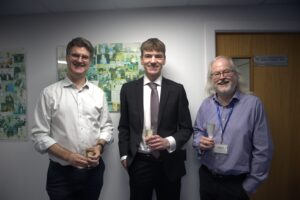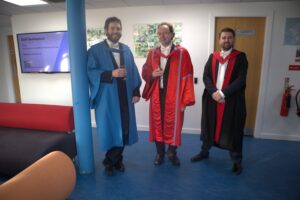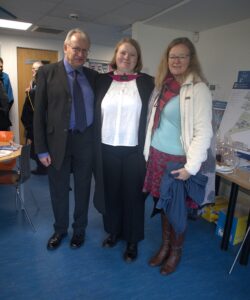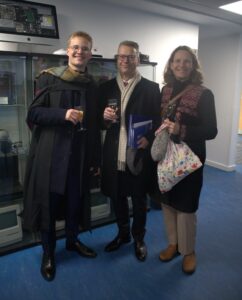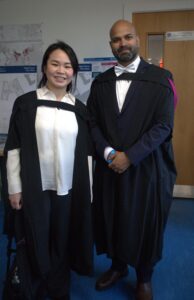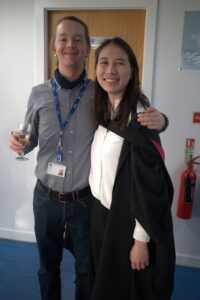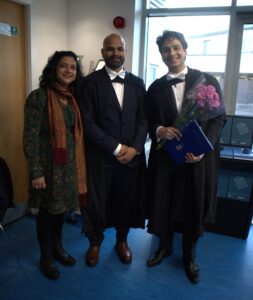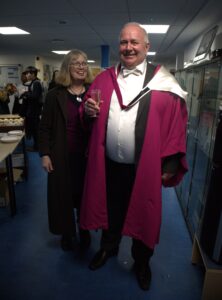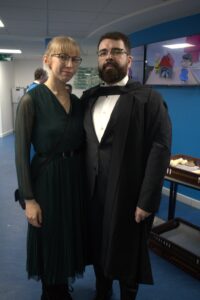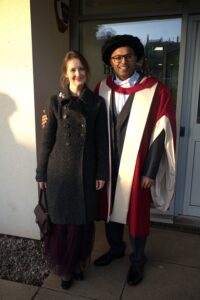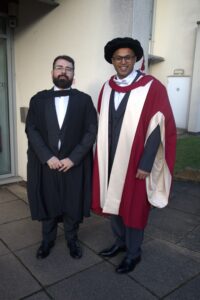Author: hdw2
🐕🦺Therapy Dogs visit to CS 🐕🦺
🐾Taking a break from revision before exams commence, students and staff enjoyed a very welcome visit from Rod Stoddart and his therapy dogs Clova, Mia and new friend Buddy.
Interaction with dogs can lower stress levels and increase happiness and motivation.
Rod has been helping people with his therapy dogs for 10 years and is available for call-outs to assist students with their well-being 24/7.
Rod can be contacted on 07780974181 or 01334 460676.
Thanks Rod, we look forward to welcoming you, Clova, Mia and Buddy again next year! 🐾
Winter Graduation 2025
PGR Seminar: Ben Claydon and Joseph Loughney
You are warmly invited to the next PGR Seminar.
![]() Monday 17/11/2025
Monday 17/11/2025
![]() 14:00-15:00
14:00-15:00
![]() JC 1.33A
JC 1.33A
- Speaker: Ben Claydon
Title: Improvements to Space Partitioning Trees for Similarity Search
Abstract: Searching large, unstructured collections of data for objects deemed of relevance to a user-provided query is an increasingly important task. For example, when a user inputs a query into a search engine, they expect a list of high-quality results to be returned nearly immediately. However, if the search engine had to rank each of the approximately 1 billion websites on the internet in order of relevance to your query, and each of these judgements took 1 microsecond, each web search would take nearly half an hour! To overcome this, data structures are created which enables searching only a small subset of the dataset, where this subset is likely to contain the most relevant items. This greatly increases the rate at which queries can be served, at the cost of some loss of accuracy. In this talk, I will present improvements made to one such data structure called random projection forests. I present a method which increases the accuracy of this algorithm without an associated increase in either preprocessing time or the time required to serve a query.
Bio: Ben is a 3rd year PhD student whose research focusses on algorithms which facilitate scalable similarity search.
- Speaker: Joseph Loughney
Title: Breaking Multiple Symmetries at Once, and Retrieving ‘Actual’ Solution Counts in Graph Search Problems
Abstract: The Subgraph Isomorphism Problem is a graph search problem which is computationally challenging to solve in large cases. We have seen significant improvements in performance as a result of symmetry breaking (avoiding searching for multiple solutions that are isomorphic to each other) either before or during search, and on either the pattern graph, the target graph, or both. Can we use any of these techniques in combination with each other? What about when counting solutions? How can we return the ‘actual’ number of solutions from the number of equivalence classes? This talk will aim to approach some answers to these questions.
We hope you can join us!
PGR Seminar: Charis Hanna and Maria Andrei
You are warmly invited to the next PGR Seminar.
Date & Time: Monday 10/11/2025 14:00-15:00
Location: JC 1.33A
- Speaker: Charis Hanna
Title: Self-Supervised Learning for Efficient Ecological Monitoring
Abstract: Cliff-nesting birds serve as valuable indicators of marine ecosystem health, yet dense populations and remote habitats present significant challenges for automated monitoring. With current state-of-the-art object detectors often failing under the conditions of extreme crowding and occlusion, this project aims to develop and refine deep learning techniques that enable the fine-grained, automated analysis of seabird colonies. Current work explores self-supervised learning strategies that leverage domain-shifted knowledge to reduce the need for exhaustive annotation across complex image datasets. These methods not only reduce the laborious process of manual annotation but also demonstrate promising improvements in performance across the long-tailed species distribution. While ongoing efforts are directed at further optimising these models, future work will leverage additional spatial information with the aim of supporting richer insights into behavioural dynamics within these populations.
Bio: Charis is a 3rd-year PhD student developing novel deep learning approaches for the automated monitoring of dense cliff-nesting bird colonies. Her research focuses on advancing computer vision methods for detection, classification, and behavioural analysis in challenging habitats.
- Speaker: Maria Andrei
Title: Bridging Psychological Distance from Climate Change through Experiential Learning within Heritage Organisations
Abstract: Climate change represents one of the most urgent challenges of our time, not only in its environmental impacts but also as a complex science communication problem. Despite broad scientific consensus on its causes and mitigation pathways, public understanding and engagement remain fragmented, limiting the collective action needed to address this crisis. My research investigates how immersive technologies, particularly virtual reality, can bridge the gap between scientific knowledge and public perception by transforming abstract climate data into tangible, emotionally resonant experiences. By connecting global and local climate futures through case studies such as Antarctica and Scotland, I examine how immersive simulations can reduce psychological distance from climate change. By evaluating audience responses across diverse contexts, from museums to polar expedition vessels, this research aims to assess how experiential storytelling can improve climate communication and motivate engagement with climate action.
Bio: Maria is a third-year PhD researcher working with the Schools of Computer Science, Biology, and Earth & Environmental Sciences. Her work focuses on immersive climate communication, using virtual reality to visualise climate impacts in regions such as Scotland and Antarctica. She collaborates with heritage organisations, science centres, and polar expedition companies to bring these experiences to communities across Scotland and beyond.
We hope you can join us!
Winter Graduation Reception
We invite our graduating students and their guests to join us for a celebration of their achievements. Please come along to a small reception with a glass of fizz and some Fisher & Donaldson cakes.
The event will take place on Tuesday 2nd December between 12.30pm and 2.30pm in the Jack Cole coffee area.
We look forward to celebrating this special occasion with you 🍾
School Seminar: Jon Rogers, “There’s plenty of room in our communities: Rethinking computational scale through open hardware”
You are warmly invited to the third School Seminar:
Speaker: Jon Rogers
Title: There’s plenty of room in our communities: Rethinking computational scale through open hardware
Abstract: The dominant business model of Big Tech is built on scale. Scale to outpace competitors, capture global markets, and consolidate control. Today, just a handful of companies mediate most online interactions, reaching billions of users across devices and platforms. This logic of exponential growth, rooted in Moore’s Law and reinforced by Thiel’s 10x principle, now drives a global race to develop increasingly powerful forms of artificial intelligence and the gigafactory-scale infrastructures needed to support them. Infrastructures that require resources that contradict plans for net zero. Is this a trajectory that is either sustainable or desirable? What might it mean to pursue scale in the opposite direction, towards smaller, more sustainable, and community-oriented forms of computation? The coming of age of open hardware offers new possibilities for computing that comes from, is made by, and is stewarded by local communities. The challenge of reimagining computing at a community scale is not primarily technical, but one of design and our ability to be more creative with technology. In doing so, we could be offering alternative digital futures that are supportive of the people and the places that we make computation for.
Bio: Jon Rogers is Professor of Creative Technology at Northumbria University , Newcastle. With a PhD in Neural Networks from Imperial College London (2001), he spent seventeen years at the University of Dundee developing research at the intersection of design and technology. His hands-on practice explores how making can reveal new stories about our relationships with emerging technologies. A former Mozilla Senior Fellow (2016–2019) in Berlin, he led the Horizon 2020 OpenDoTT doctoral programme on trust and the Internet of Things. His current research reimagines digital futures through open hardware to enable more open and self-determined technological practices within communities.
Date & Time: Tuesday 11/11/2025 10am-11am.
Location: JC 1.33A
Note: Jon has kindly agreed to stay until 2 p.m. If you’d like to talk to him, please come see him after the talk.
Please do come along and join us! 🙂
AI Seminar – Symbolic reasoning with Dr Ruth Hoffmann Wednesday 29 October
Please join us for an in-person event entitled ‘Symbolic reasoning’ on Wednesday 29 October 2025 between 1:30pm and 3pm. To help monitor attendance, please register using the link below. This event is open to all members of the community at the University of St Andrews.
Speaker: Dr Ruth Hoffman, School of Computer Science, University of St Andrews
Abstract: Symbolic Reasoning (or Symbolic AI) consists of the logical modelling and an exhaustive search for definite solutions to problems. Whether that is finding the solution of a sudoku, finding an optimal route for delivery vehicles or creating kidney matching chains, symbolic AI and logic are the building blocks of this type of reasoning. We will be exploring the foundations of (Symbolic) AI, logic and search, and what type of intelligence it might represent.
Speaker bio: Dr Ruth Hoffmann is a Lecturer at the School of Computer Science, where she is also the Head of the AI Research Theme. She obtained her PhD at St Andrews and has spent some time at the University of Glasgow before returning to St Andrews. She has a background in Discrete Mathematics and Computational Combinatorics. Her research broadly focuses on efficiently finding (smaller) patterns inside bigger (target) structures. Currently, she is teaching the Symbolic AI module she developed.
Ruth is leading an UKRI project on improving search algorithms in one field, while taking inspiration from another search. She is a reviewer for numerous top AI, and Constraints venues, and a co-chair for a coding workshop for GAP (a computational algebra tool).
Register here following the ‘Book tickets’ link (registration is free)
Venue: St Mary’s College: T205 – Lecture Room 2
Directions: St Mary’s Lecture Theatre 2 – entering St Mary’s Quad from South Street, go through the door roughly in the middle of the building on the right, head up the spiral staircase to the first floor and go South (there are also signs).
We hope to see many of you there!
PGR Seminar – Erdem Kus & Junyu Zhang
You are warmly invited to the next PGR Seminar.
Date & Time: Monday 20/10/2025 14:00-15:00
Location: JC 1.33A
- Speaker: Erdem Kus
Title: Frugal Algorithm Selection for Combinatorial Search
Abstract: Solvers for combinatorial search and optimisation problems often exhibit highly complementary performance: instances that are hard for one solver may be easy for another. The Algorithm Selection Problem (ASP) addresses this by predicting, for each problem instance, which solver will perform best. Machine learning models trained for this purpose, however, are typically expensive to construct, as they require exhaustive solver runs on all training instances to obtain ground-truth performance data.
In this work, we propose a frugal alternative that formulates algorithm selection as an active learning problem. Instead of uniformly evaluating all solver–instance pairs, our method intelligently selects the most informative ones, thereby drastically reducing the cost of data collection. We show that standard active learning techniques are inadequate for this setting, as they overlook the structure and cost characteristics unique to algorithm selection. To address this, we introduce novel, cost-aware active learning strategies that leverage auxiliary models to balance informativeness and evaluation cost.
Bio: Erdem is a PhD candidate whose research focuses on Artificial Intelligence (AI) and Constraint Programming (CP).
- Speaker: Junyu Zhang
Title: Remaking Characters in Heritage Contexts to Support Inclusive Learning
Abstract: Characters in immersive environments have the potential to enrich user experience, improving engagement with heritage and in so doing benefiting heritage organisations and their communities. Creating authentic digital scenes based upon survey, archaeological and historical data, co-creative design and community engagement enables communities and their visitors to understand the past better. The understanding of authenticity stimulates the potential of enriching cultural heritage with the details of lives past and also discusses how this research benefits the Sustainable Development Goals.
Bio: Minty is a PhD candidate exploring the authenticity of characters to support inclusive learning in heritage contexts. She is interested in how digital technologies can be used in the intersection of different disciplines to achieve SDGs in the field of cultural heritage, so as to enhance the promotion, representation, and well-being in digital humanities education and also affect resonated dialogue and thinking among diverse people and communities in facing the current challenges.
We hope you can join us!
Inaugural Lecture showcase Wednesday 15th October
The Inaugural Lecture showcase takes place at Buchanan Lecture Theatre on Wednesday 15th October at 4:00pm.
Professor Richard Connor
‘Finding New Dogs with Old Tricks’
Professor Juliana Bowles
‘The Temporality of Formal Reasoning: As it was, as it is and as it could be’
Professor Susmit Sarkar
‘Peering Inside the Box: Making Modern Computing Safer with Mathematical Specifications’
Please come along if you can and support the school and our colleagues.



